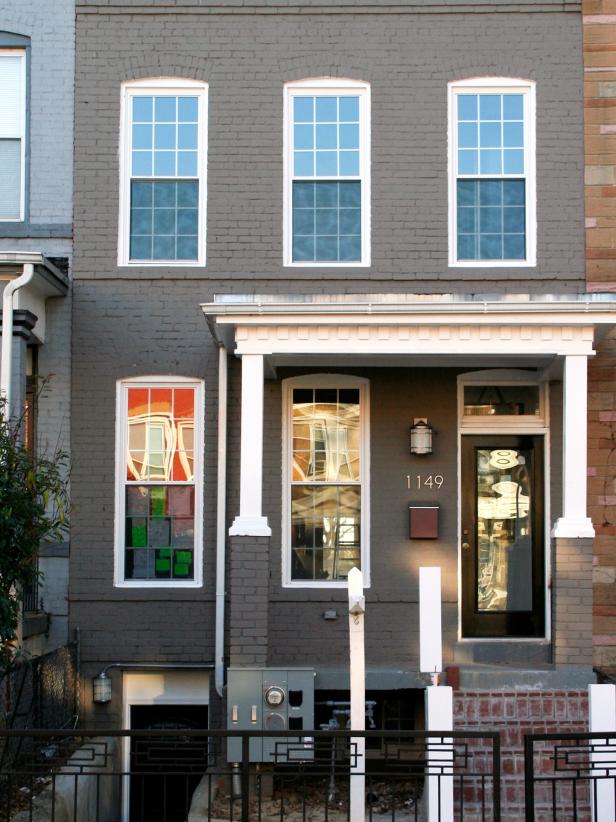Row House Architecture

A row house is, as the name suggests, one of many houses in a row. The style is mostly found in densely populated urban areas, where space is limited.
If you remember the classic TV sitcom Full House (1987-1995), you've seen row houses. Each episode would often flash a few quick shots of where the Tanner clan lived -- a home attached to several other houses, all of them, in this case, Victorian-era houses that were built in San Francisco between 1892 and 1896.
The row house style has flourished for various reasons. For one, as cities grew, space became an issue. For much of the 19th century, you couldn't build very far upward, so a high-rise apartment complex was out of the question. Sandwiching houses together made sense as land became scarce. Construction methods and financial benefits also contributed to the popularity of row houses, which have been around since the 1600s. Row houses allowed builders to easily create homes, since they built several of them at one time. In addition, a developer was able to purchase one plot of land and then split up the territory in a way that would allow them to get more buyers.
Key Elements
- Two stories. Some row houses have had a business on the bottom, like a grocery store, and one home upstairs, but typically, these are for one family to live in -- on both floors.
- Traditional layout. Similar to many homes, the living room is usually in the front, followed by a dining room and then a kitchen in the back. The bedrooms are upstairs. There is sometimes a basement or partial basement.
- Side hallways. The hallway is usually on the side of a row house, with the stairway leading up to the second floor.
- Lack of lawn. In many cases, there is no yard.
Famous Examples
- Elfreth's Alley. It's in Philadelphia, and one of the oldest residential streets in America. Dating back to the early 1700s, Elfreth's Alley is a National Historic Landmark. The alley is filled with row houses, although these are unique in that all of the row houses are different -- they're built together, but they don't look alike. There is a narrow sidewalk separating the homes from a very narrow street.
- Beacon Hill. It's a neighborhood in Boston, a National Historic District and well-known for its affluent row houses. At one time or another, residents here have included everyone from Louisa May Alcott, Robert Frost and Daniel Webster, to David Lee Roth and Carly Simon. The fictitious and real bar Cheers is also noted for being in Beacon Hill.
- Flushing, New York. Since we've mentioned Full House and Cheers, let's point out that if you go onto Cooper Street, you can see the house that stood in for Archie Bunker's house. The Bunker clan lived in a two-home row house. That is, there were many row houses on the street, but instead of being, say, eight houses, two houses were attached, and an alley separated each two-home row house.
Practically Speaking: Hassles and Headaches
As the Bunkers and the family next door, the Jeffersons, could have told you, it helps if you like your neighbors. You will be close together.
It's less of an issue for the row houses made of solid brick, but when one row house catches on fire, the others all too easily can go up in flames.
Ironically, you can have the same problem with water, points out Nancy Joyce, a Chicago-based real estate broker who sells "predominantly vintage properties" and describes herself as an "architectural history buff." Joyce says that "if one person has a leak on their side, you might have water coming out on your side of the wall."
Likewise, Joyce notes that row houses built during the prewar era (1890-1940) didn't have the greatest sound-proofing, so that's something to mull over if you're buying an older row house.
Row houses, as a general rule, don't have attached garages, so there can be parking issues. Fortunately, in many cities, there is off-street parking, and frequently walking is the preferred method of transportation, so it may not be a problem. Still, it's something to consider.
And some of the stairways can be narrow in a row house. You might want to bring a measuring tape to make sure you can haul up any oversized furniture to the bedroom.
House Hunting
Go deep. Into the city.
That said, depending on what you're looking for, you will find some row houses in small towns scattered across America -- they just aren't likely to be the kind of row houses that are typically shown on TV and in the movies. Some modern-day townhomes are considered to be row houses, for instance. They're often a far cry from what most people perceive to be a row house, although many of them are arguably just as nice, or not so nice, of a place to live.
But for all of the aforementioned hassles of a row house, many of them are in wonderful neighborhoods because the best of them are recognized by homeowners and home sellers as something really special.
"They're not hard to sell," says Joyce of row houses. "For a certain price point, it can be an excellent way of living in a great neighborhood. If you can snag a good Victorian-era row house, and you're two doors away from a four-million stand-alone house, you'll see what I mean. Of course, your taxes will be higher, but you'll be closer to the zoo, the lake, snappy restaurants."
Joyce is thinking of Chicago and its shimmering Lake Michigan, but she could well be describing most cities and their row houses. "The closer to the green and water, the more your values hold," she observes.




































